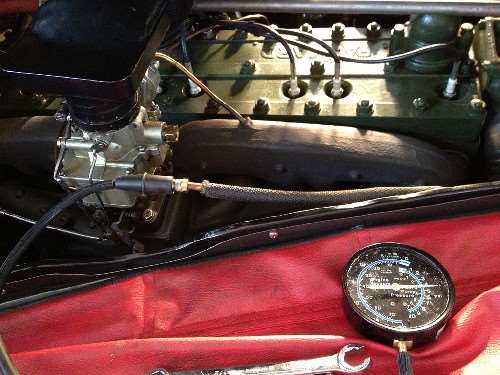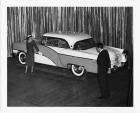|
Re: The Duchess Project: 1940 Super 8 Convertible Sedan
|
||||
|---|---|---|---|---|
|
Home away from home
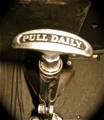
|
Some great things are being done with 3D printing. Is there any chance you could have your faceplate scanned and then printed? These folks appear localism:
adxportland.com/services/3d-printing-2/
Posted on: 2013/5/10 12:57
|
|||
|
||||
|
Re: The Duchess Project: 1940 Super 8 Convertible Sedan
|
||||
|---|---|---|---|---|
|
Home away from home

|
Not to high jack this thread, but I hope that 3d printer could be used for some parts, like the factory AC vents for the V8 cars. A discussion on 3D printers was on this thread,packardinfo.com/xoops/html/modules/newbb ... um=4&post_id=110252#forumpost110252
Posted on: 2013/5/10 13:11
|
|||
|
||||
|
Re: The Duchess Project: 1940 Super 8 Convertible Sedan
|
||||
|---|---|---|---|---|
|
Home away from home

|
Hello Joe:
Regarding your radio face plate - I would go to Jerry Vinarcik at Yesterday's Radio> Click onto his catalogue here: yesterdaysradio.com/pdfs/catalog.pdf Go to page 2 of the catalogue and I think he has your part listed separately and part of a full package of dash plastic. Best, --Roger--
Posted on: 2013/5/10 15:31
|
|||
|
||||
|
Re: The Duchess Project: 1940 Super 8 Convertible Sedan
|
||||
|---|---|---|---|---|
|
Home away from home
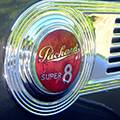
|
Thanks, guys.
I PM'd Jerry because my plate doesn't have as many holes as the drawing of the escutcheon in the catalog on page 2 that's plastic or the one that's chrome on page 17. Also contacted ADX to get a ballpark price on a 3D one before I take it across town. Or I may have to get innovative. Attach file:  (21.56 KB) (21.56 KB)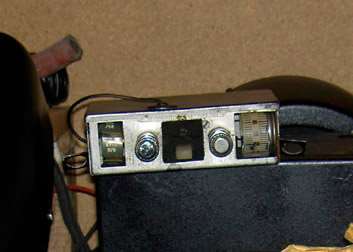
Posted on: 2013/5/10 16:17
|
|||
|
||||
|
Re: The Duchess Project: 1940 Super 8 Convertible Sedan
|
||||
|---|---|---|---|---|
|
Home away from home

|
CARBURETOR
The official photo of the fuel pressure test is below, but the original had a bath-towell and fire extinguisher in it. Plenty of cautions in the instructions. What is all this trepidation about? You're car guy now. Gee, it was so easy. Car cranked up running on the fuel in the bowl and the needle swung over to 4, almost lbs of pressure. Easy as pie. No explosions, fires, etc. Of course, one danger, they don't mention. The big surprise of spurting gas when you disconnect almost 5 PSI of fuel. So I did need the towel after all. But I got a good reading. It takes 2 people for the fuel delivery test, so I didn't do. Maybe the vacuum advantage isn't working. Three things. The vacuum from the carburetor, which could be switch to the manifold. The diaphragm (if the advance level doesn't on acceleration, and the spring, if it doesn't retract when acceleration is released. The latter require 2 guys or more and longer arms. Like Sonny Liston could do it, but that's about all. The vacuum I could test. There's a movie of it here: http://www.mktx.com/joe/CarbVacuumAdvTest-desktop.m4v Popped right up to between 15 and 20 in. of Hg. Since those things seemed to be working. I removed the carburetor again. Opened it up again. I sprayed it with acetone. The new leather piston looked good. Then I checked the floats. I removed them and held them down in a pot of water. No bubbles. The measuring device that came with the kit is pretty crude, but they looked like they were in the ballpark. I had to leave for the airport, so I didn't get a chance to see if gas is still above the level hole. I'll do that tonight and if so, I'll bend them up (per the photo) which is actually down, using a precise measurement device. The fluffing problem is related to heat. It doesn't happen when I "push" pedal to the metal (brief) through all gears within the first, say, 15 minutes of operation. But once it warms up, to normal, straight up, the fluffing begins if I push it.
Posted on: 2013/5/13 19:13
|
|||
|
||||
|
Re: The Duchess Project: 1940 Super 8 Convertible Sedan
|
||||
|---|---|---|---|---|
|
Home away from home
|
"...Maybe the vacuum advantage isn't working. Three things. The vacuum from the carburetor, which could be switch to the manifold. The diaphragm (if the advance level doesn't on acceleration, and the spring, if it doesn't retract when acceleration is released. The latter require 2 guys or more and longer arms. Like Sonny Liston could do it, but that's about all. The vacuum I could test. There's a movie of it here:
http://www.mktx.com/joe/CarbVacuumAdvTest-desktop.m4v Popped right up to between 15 and 20 in. of Hg..." Joe, not sure what you are getting at with the above. Vacuum should be steady at idle and closer to 20 in. than 15 in. The distributor vacuum advance diaphragm will react or move depending on the amount of vacuum applied to it. If connected to the manifold, there will always be some vacuum applied to the advance diaphragm all the time the engine is running. If connected to the carburetor, then vacuum will not be present at idle, only as the throttle plates are opened. "Since those things seemed to be working. I removed the carburetor again. Opened it up again. I sprayed it with acetone. The new leather piston looked good. Then I checked the floats. I removed them and held them down in a pot of water. No bubbles. The measuring device that came with the kit is pretty crude, but they looked like they were in the ballpark..." The paper gauge supplied with the carburetor rebuild kit looks to be bent or wavey and therefore not giving an accurate reading. If straightened, the floats would need to be adjusted and would result in a lower fuel level. A small difference in float setting can make a big difference. A small mechanic's square would be a better tool to measure the floats. Keep at it you will prevail. (o{}o)
Posted on: 2013/5/14 10:54
|
|||
|
We move toward
And make happen What occupies our mind... (W. Scherer) |
||||
|
||||
|
Re: The Duchess Project: 1940 Super 8 Convertible Sedan
|
||||
|---|---|---|---|---|
|
Home away from home

|
Thanks, JW, for the ifo and encouragement.
I re-read my comments. You'd need a doctorate in hieroglyphics or Google's computer program that asks "Did you mean...?" to understand what I wrote. I need to edit my comments before posting. What I was saying was that I wondered if the vacuum advance might not be working, causing the fluffing problem when the engine is hot and under stress...like a hill...when the accelerator is depressed. There were 3 places that could cause the distributor spark advance (not advantage) not to work: 1. Little or no vacuum from the base of the carburetor, where the distributor vacuum advance is connected now. (The result of that test is the movie I posted, which I'm not sure anyone can view, but it shows, as you described, no vacuum at idle, and up to 20 in.Hg with a little depressing of the accelerator. That works. If I didn't get much vacuum, I would have switched the tube to connect at the rear exhaust manifold. I may still do that, based on your recommendation re the overheating at idle on a hot day. But I also understand that the timing would have to be adjusted because some vacuum would be present at idle when connected to the manifold.) 2. The vacuum advance diaphragm is split. If the lever (not level) ,the arm, does not move when vacuum is applied revving-up, then the diaphragm is torn. 3. The spring on the arm is broken. If the arm moves, but doesn't retract, then the spring is weak, broken, disconnected. How does one person test the movement of the diaphragm or the arm? If I take the distributor cap off to look in there, the car won't run. Setting the floats accurately I didn't get to it last night, but will tonight.
Posted on: 2013/5/14 11:45
|
|||
|
||||
|
Re: The Duchess Project: 1940 Super 8 Convertible Sedan
|
||||
|---|---|---|---|---|
|
Forum Ambassador

|
Easy enough to check the vacuum advance, just draw a vacuum on it with your mouth and check for movement. If it won't hold a vacuum (which I suspect is likely given your symptoms), the diaphragm is leaking and you'll need a replacement.
Posted on: 2013/5/14 12:38
|
|||
|
||||
|
Re: The Duchess Project: 1940 Super 8 Convertible Sedan
|
||||
|---|---|---|---|---|
|
Home away from home
|
Joe, thanks for the clarification. What you describe when reading the gauge connected to the distributor advance tubing would be correct: no vacuum at idle as the port in the carburetor is covered by the throttle plates. IF you decide to change the vacuum line connection to the manifold, there would be no need to readjust the timing, just the idle speed and mixture settings. It would be a simple thing to do and you should notice results immediately. Real curious how this "fix" would work on a Packard.
(o{}o)
Posted on: 2013/5/14 16:01
|
|||
|
We move toward
And make happen What occupies our mind... (W. Scherer) |
||||
|
||||

